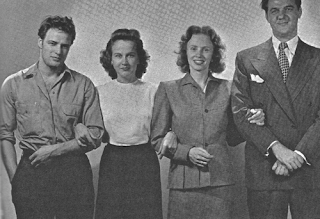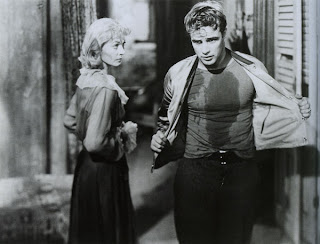 "I dream of her, underneath the ceiling fan spinning in my room, and she becomes even more resplendent than a diamond".
"I dream of her, underneath the ceiling fan spinning in my room, and she becomes even more resplendent than a diamond". "I remember everything, even the dates. But I don't want others to remember the details, just the image". -Gloria Grahame
"I remember everything, even the dates. But I don't want others to remember the details, just the image". -Gloria Grahame Gloria Grahame with director Richard Whorf on the set of "Blonde Fever" (1944), in her first film performance.
Gloria Grahame with director Richard Whorf on the set of "Blonde Fever" (1944), in her first film performance. In "Blonde Fever" (MGM, 1944), Gloria Grahame's character was introduced with the prophetic line: "You're destined to make wise men foolish". She learned her Shakespeare chapter and verse, but if they wanted ther to swing her hips and bat her vampish eyes, why not?
In "Blonde Fever" (MGM, 1944), Gloria Grahame's character was introduced with the prophetic line: "You're destined to make wise men foolish". She learned her Shakespeare chapter and verse, but if they wanted ther to swing her hips and bat her vampish eyes, why not? Gloria settled for the part of a slinky gambling house girl (Margie) in the film "Macao" (RKO, 1952, directed by Josef von Sternberg, Nicholas Ray and Robert Stevenson).
Gloria settled for the part of a slinky gambling house girl (Margie) in the film "Macao" (RKO, 1952, directed by Josef von Sternberg, Nicholas Ray and Robert Stevenson). Although she had success with supporting parts in major films such as "The Bad and the Beautiful", "The Greatest Show on Earth" and "Oklahoma!", the breakthrough leading role eluded her. Dark City became her permanent address.
Although she had success with supporting parts in major films such as "The Bad and the Beautiful", "The Greatest Show on Earth" and "Oklahoma!", the breakthrough leading role eluded her. Dark City became her permanent address. "A Woman's Secret", "In A Lonely Place", "Sudden Fear", "The Big Heat", "Human Desire", "Naked Alibi", "Odds Against Tomorrow": a gallery of screw-loose but seductive women, all aching to break out of the conscripted margins of a man's world, but trapped by their own compulsions and insecurities.
"A Woman's Secret", "In A Lonely Place", "Sudden Fear", "The Big Heat", "Human Desire", "Naked Alibi", "Odds Against Tomorrow": a gallery of screw-loose but seductive women, all aching to break out of the conscripted margins of a man's world, but trapped by their own compulsions and insecurities. In her personal life Gloria pursued the kind of rugged, self-determined men that she clung to in the movies... She was married and divorced four times, with a list of lovers longer than her film credits. George Englund, a producer and an early suitor of Gloria's, explained her promiscuity as untamed.
In her personal life Gloria pursued the kind of rugged, self-determined men that she clung to in the movies... She was married and divorced four times, with a list of lovers longer than her film credits. George Englund, a producer and an early suitor of Gloria's, explained her promiscuity as untamed. Gloria Grahame and Frank Sinatra as Nurse and Danny in "It Happened in Brooklyn" (1947) directed by Richard Whorf
Gloria Grahame and Frank Sinatra as Nurse and Danny in "It Happened in Brooklyn" (1947) directed by Richard Whorf Gloria Grahame as Beulah Baxter on the set of "Merton of the Movies" (1947) directed by Robert Alton
Gloria Grahame as Beulah Baxter on the set of "Merton of the Movies" (1947) directed by Robert Alton Jane Greer's flashing cunning eyes betray a depthless venality not apparent in her slightly plump, puckish face. Jane Greer was tight with a pair of Dark City's favorite daughters: Gloria Grahame and Audrey Totter -imagine the slumber parties!
Jane Greer's flashing cunning eyes betray a depthless venality not apparent in her slightly plump, puckish face. Jane Greer was tight with a pair of Dark City's favorite daughters: Gloria Grahame and Audrey Totter -imagine the slumber parties! Gloria's first starring role, opposite Humphrey Bogart in "In A Lonely Place" (1950), should have made her a front-line star. But in Hollywood, the performance was secondary to the strangeness surrounding its creation.
Gloria's first starring role, opposite Humphrey Bogart in "In A Lonely Place" (1950), should have made her a front-line star. But in Hollywood, the performance was secondary to the strangeness surrounding its creation.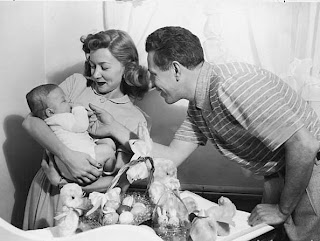 Her marriage to the film's director, Nicholas Ray, was disintegrating, and to preclude production problems, Grahame had to sign a contract stipulating that she would accede to all of Ray's on-set demands. The finished film was a thinly-veiled portrait of their hopeless union.
Her marriage to the film's director, Nicholas Ray, was disintegrating, and to preclude production problems, Grahame had to sign a contract stipulating that she would accede to all of Ray's on-set demands. The finished film was a thinly-veiled portrait of their hopeless union. Even winning an Oscar (Best Supporting Actress of 1952, for "The Bad and the Beautiful") had its pitfalls. In the ceremony's first-ever national broadcast, Gloria stumbled badly on ther way to the stage. To the rumor-mongering public, her image was confirmed as a lovable drunken whore.
Even winning an Oscar (Best Supporting Actress of 1952, for "The Bad and the Beautiful") had its pitfalls. In the ceremony's first-ever national broadcast, Gloria stumbled badly on ther way to the stage. To the rumor-mongering public, her image was confirmed as a lovable drunken whore. Gloria Grahame as Marianna in "Naked Alibi" (1954) directed by Jerry Hopper
Gloria Grahame as Marianna in "Naked Alibi" (1954) directed by Jerry Hopper As producers during the Fifties continued to trade on her sex appeal, she became increasingly insecure about her looks. She had numerous plastic surgeries on her upper lip, obsessively trying to enhance the lush pout that she thought was essential to her allure. She lifted weights in the hope of enlarging her breasts, which, unlike her mouth, she refused to have surgically altered.
As producers during the Fifties continued to trade on her sex appeal, she became increasingly insecure about her looks. She had numerous plastic surgeries on her upper lip, obsessively trying to enhance the lush pout that she thought was essential to her allure. She lifted weights in the hope of enlarging her breasts, which, unlike her mouth, she refused to have surgically altered. During her last years she battled cancer in her own holistic, narcissistic way, refusing any treatment that altered her physical appearance. She died in 1981, at the age of 56, from septic shock suffered when a doctor punctured her bowel trying to drain fluid from her cancerous stomach. It was a sad life, but not a tragic one.
During her last years she battled cancer in her own holistic, narcissistic way, refusing any treatment that altered her physical appearance. She died in 1981, at the age of 56, from septic shock suffered when a doctor punctured her bowel trying to drain fluid from her cancerous stomach. It was a sad life, but not a tragic one. In the Dark City district she inhabited, she left a unique legacy, including the most heartbreaking lines in film noir (from "In A Lonely Place"): "I was born when you kissed me, I died when you left me, I lived a few weeks while you loved me". -"Dark City: The Lost World of Film Noir" by Eddie Muller (1998)
In the Dark City district she inhabited, she left a unique legacy, including the most heartbreaking lines in film noir (from "In A Lonely Place"): "I was born when you kissed me, I died when you left me, I lived a few weeks while you loved me". -"Dark City: The Lost World of Film Noir" by Eddie Muller (1998) John Garfield, Gregory Peck, Dorothy McGuire and Celeste Holm in "Gentleman's Agreement" (1947): Gregory Peck plays a journalist who pretends to be Jewish in order to write a story on anti-Semitism. The film received eight Academy Award nominations and won three Oscars.
John Garfield, Gregory Peck, Dorothy McGuire and Celeste Holm in "Gentleman's Agreement" (1947): Gregory Peck plays a journalist who pretends to be Jewish in order to write a story on anti-Semitism. The film received eight Academy Award nominations and won three Oscars. In her first role - that of Sally Murfin in "Blonde Fever" (1944) - Gloria's character states: 'Mr. Donay, there are two kinds of girls - good girls and the other kind. I hope you don't think I'm the other kind.' After appearances in such films as "Song of the Thin Man", Gloria found a premium vehicle for exposure as Ginny Tremaine in RKO's "Crossfire" - directed by Edward Dmytryk in 1947. Although not a starring role, it would prove to be the film capable of escalating her to stardom and eventually far more defining performances.
In her first role - that of Sally Murfin in "Blonde Fever" (1944) - Gloria's character states: 'Mr. Donay, there are two kinds of girls - good girls and the other kind. I hope you don't think I'm the other kind.' After appearances in such films as "Song of the Thin Man", Gloria found a premium vehicle for exposure as Ginny Tremaine in RKO's "Crossfire" - directed by Edward Dmytryk in 1947. Although not a starring role, it would prove to be the film capable of escalating her to stardom and eventually far more defining performances. Her excellent work in "Crossfire" was gratifyingly nominated for an Academy Award (eventually losing to Celeste Holm in "Gentleman's Agreement"). Source: www.dvdbeaver.com
Her excellent work in "Crossfire" was gratifyingly nominated for an Academy Award (eventually losing to Celeste Holm in "Gentleman's Agreement"). Source: www.dvdbeaver.com Gloria Grahame as Helen in "Odds Against Tomorrow" (1959) directed by Robert Wise
Gloria Grahame as Helen in "Odds Against Tomorrow" (1959) directed by Robert Wise Abraham Polonsky directing John Garfield and Beatrice Pearson in a scene from "Force of Evil" (1947)
Abraham Polonsky directing John Garfield and Beatrice Pearson in a scene from "Force of Evil" (1947)Abraham Polonsky remains one of the great creative forces in noir cinema simply on the basis of two works —the definitive boxing film, "Body and Soul", for which he wrote the screenplay, and the brilliant "Force of Evil", perhaps the most passionate and philosophically resonant of all films noirs. Polonsky also wrote the screenplay for Don Siegel’s "Madigan" (1968), and, as was only recently acknowledged, he wrote (uncredited) the screenplay for Robert Wise’s 1959 "Odds against Tomorrow", when he was blacklisted from the industry.
 John Garfield, the most biblically angry of all the young men of the screen for whom he must be acknowledged as prototype —James Dean, Marlon Brando, Robert De Niro— has only grown in complexity and stature as the affectations of his successors dim in light of his striking authenticity of manners.
John Garfield, the most biblically angry of all the young men of the screen for whom he must be acknowledged as prototype —James Dean, Marlon Brando, Robert De Niro— has only grown in complexity and stature as the affectations of his successors dim in light of his striking authenticity of manners. "I went to the various meetings of the Committee for the First Amendment", Abraham Polonsky recalled, "but no one was there by the second meeting. I remember Humphrey Bogart walking around the room saying to everybody ‘You sold me out!’ He said ‘The hell with all of you. If you don’t want to fight, I’ll take care of myself!’ and Bogart stormed out of the room".
"I went to the various meetings of the Committee for the First Amendment", Abraham Polonsky recalled, "but no one was there by the second meeting. I remember Humphrey Bogart walking around the room saying to everybody ‘You sold me out!’ He said ‘The hell with all of you. If you don’t want to fight, I’ll take care of myself!’ and Bogart stormed out of the room". Among the artists for whom the blacklist period was indeed a defining “noir” moment in their lives were producer and writer Adrian Scott (Murder, My Sweet; Deadline at Dawn); screenwriters Albert Maltz (This Gun for Hire, The Naked City) and Dalton Trumbo (Gun Crazy [Deadly Is the Female], The Prowler); screenwriter and director Abraham Polonsky (Body and Soul, Force of Evil, Odds against Tomorrow, Madigan); directors Edward Dmytryk (Murder, My Sweet; Cornered; Crossfire; The Hidden Room [Obsession]), Jules Dassin (Brute Force, The Naked City, Thieves’ Highway, Night and the City, Rififi), John Berry (Tension, He Ran All the Way), and Joseph Losey (M, The Prowler, The Big Night); and actors Marsha Hunt (Raw Deal) and John Garfield (Body and Soul, Force of Evil, The Breaking Point, He Ran All The Way). "Street with No Name: A History of the Classic American Film Noir" by Andrew Dickos (2002)
Among the artists for whom the blacklist period was indeed a defining “noir” moment in their lives were producer and writer Adrian Scott (Murder, My Sweet; Deadline at Dawn); screenwriters Albert Maltz (This Gun for Hire, The Naked City) and Dalton Trumbo (Gun Crazy [Deadly Is the Female], The Prowler); screenwriter and director Abraham Polonsky (Body and Soul, Force of Evil, Odds against Tomorrow, Madigan); directors Edward Dmytryk (Murder, My Sweet; Cornered; Crossfire; The Hidden Room [Obsession]), Jules Dassin (Brute Force, The Naked City, Thieves’ Highway, Night and the City, Rififi), John Berry (Tension, He Ran All the Way), and Joseph Losey (M, The Prowler, The Big Night); and actors Marsha Hunt (Raw Deal) and John Garfield (Body and Soul, Force of Evil, The Breaking Point, He Ran All The Way). "Street with No Name: A History of the Classic American Film Noir" by Andrew Dickos (2002) "Women either want to mother me or fuck me", John Garfield told singer Margaret Whiting. Actor Robert Brown ran into Garfield one day at McSorley's Saloon and asked him what he was doing there. "I'm drying out," Garfield replied. "What are you drying out from?", Brown asked. "Women!", Garfield responded. The FBI asked him about a certain woman he had slept with and who had Communist Party affiliations. Garfield replied that he could recall the name of every woman he had ever had an affair with, and that woman's name was unfamiliar to him.
"Women either want to mother me or fuck me", John Garfield told singer Margaret Whiting. Actor Robert Brown ran into Garfield one day at McSorley's Saloon and asked him what he was doing there. "I'm drying out," Garfield replied. "What are you drying out from?", Brown asked. "Women!", Garfield responded. The FBI asked him about a certain woman he had slept with and who had Communist Party affiliations. Garfield replied that he could recall the name of every woman he had ever had an affair with, and that woman's name was unfamiliar to him. Nelson Algren did like the idea of John Garfield playing his novel's ("The Man with the Golden Arm") protagonist, Frankie Machine. "He worked very hard at being who he was supposed to be. He knew he wasn't who he was. I mean the screen image. He was trying to be like the screen image." -said Algren of Garfield. When Garfield died he had about $130,000 in the bank. For 1952, that was a substantial sum, but not for a major movie star.
Nelson Algren did like the idea of John Garfield playing his novel's ("The Man with the Golden Arm") protagonist, Frankie Machine. "He worked very hard at being who he was supposed to be. He knew he wasn't who he was. I mean the screen image. He was trying to be like the screen image." -said Algren of Garfield. When Garfield died he had about $130,000 in the bank. For 1952, that was a substantial sum, but not for a major movie star. Solace came in the form of a woman. While previewing 'Golden Boy' in Hartford, Garfield met actress/interior designer Iris Whitney. A native of Pasadena, California, Whitney had been a child dancer and actress who had played small roles in several hit plays of the 1930s, including "The Petrified Forest" and "Abe Lincoln" in Illinois. She was blonde, vibrant and well built, a good time girl. "He was uncomfortable in his marriage at the time, and I introduced him to Iris Whitney", Robert Whitehead recalled, "They hit it off right away." Garfield had experienced so many casual affairs over the years that no one felt that he would fall for anyone. With Whitney it may have been something else altogether. "I was surprised when he told me he was going for her," Robert Whitehead said, "He hoped to return to Broadway full time". Garfield was trying to acquire the stage rights to one of his biggest film hits, "The Postman Always Rings Twice". -"He Ran All the Way: The Life of John Garfield" by Robert Nott (2004)
Solace came in the form of a woman. While previewing 'Golden Boy' in Hartford, Garfield met actress/interior designer Iris Whitney. A native of Pasadena, California, Whitney had been a child dancer and actress who had played small roles in several hit plays of the 1930s, including "The Petrified Forest" and "Abe Lincoln" in Illinois. She was blonde, vibrant and well built, a good time girl. "He was uncomfortable in his marriage at the time, and I introduced him to Iris Whitney", Robert Whitehead recalled, "They hit it off right away." Garfield had experienced so many casual affairs over the years that no one felt that he would fall for anyone. With Whitney it may have been something else altogether. "I was surprised when he told me he was going for her," Robert Whitehead said, "He hoped to return to Broadway full time". Garfield was trying to acquire the stage rights to one of his biggest film hits, "The Postman Always Rings Twice". -"He Ran All the Way: The Life of John Garfield" by Robert Nott (2004) A smiling John Garfield (1939)
A smiling John Garfield (1939)John Garfield collapsed at Iris Whitney's Gramercy Park apartment on 21st May 1952. Miss Whitney put him to bed with a glass of orange juice on his night table. When she woke up the next morning, she found the orange juice untouched and Garfield dead.
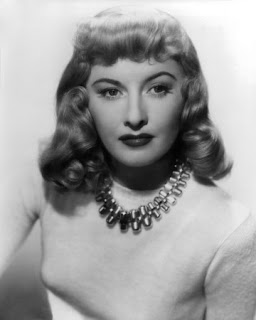 "Double Indemnity created a tense climate dominated by a perverse eroticism where woman, to be angelic and demonic, recovers under the appearance of voluptuous ecstasy, the devastating attraction of Eros and Thanatos".—Jean Mitry, "Histoire du Cinéma"
"Double Indemnity created a tense climate dominated by a perverse eroticism where woman, to be angelic and demonic, recovers under the appearance of voluptuous ecstasy, the devastating attraction of Eros and Thanatos".—Jean Mitry, "Histoire du Cinéma""The Postman Always Rings Twice" was first published in 1934, and feature film versions were made in wartime Italy (1942) and then twice in Hollywood (1946 and 1981). Said to be the inspiration for Camus’ existentialist classic "L’Etranger" (The Stranger), "The Postman" paved the way for James M. Cain's later successes "Double Indemnity" (published 1936, filmed 1944) and "Mildred Pierce" (1945).
 Hollywood’s first version, when it materialised in 1946, was credited with “nearly destroying the dam” of censorship. Even in the 1980s, pulp fiction devotee Geoffrey O’Brien described its protagonists living “an insectlike life without memory or intellect”. Yet others elevated James M. Cain to the pantheon of great American writers like Ring Lardner, Hemingway and Erskine Caldwell; director Lewis Milestone called him “the American Dostoevsky”.
Hollywood’s first version, when it materialised in 1946, was credited with “nearly destroying the dam” of censorship. Even in the 1980s, pulp fiction devotee Geoffrey O’Brien described its protagonists living “an insectlike life without memory or intellect”. Yet others elevated James M. Cain to the pantheon of great American writers like Ring Lardner, Hemingway and Erskine Caldwell; director Lewis Milestone called him “the American Dostoevsky”.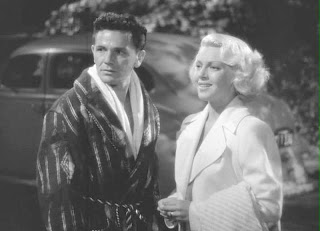 John Garfield and Lana Turner as Frank Chambers and Cora Smith in "The Postman Always Rings Twice" (1946) directed by Tay Garnett
John Garfield and Lana Turner as Frank Chambers and Cora Smith in "The Postman Always Rings Twice" (1946) directed by Tay Garnett The film’s fatalism, as the characters acknowledge their powerlessness to resist their fate, taps a dark undercurrent in 1940s America that finds parallels with the helplessness of the Depression years that spawned the book. But unlike the darkness of the 1940s film noir aesthetic, 1930s writers such as “Cain and Hammett and Horace McCoy deal in a clear unblinking light”. It is not noir’s visual darkness but its fatalism that links the 1930s and 1940s in Postman’s narrative posture.
The film’s fatalism, as the characters acknowledge their powerlessness to resist their fate, taps a dark undercurrent in 1940s America that finds parallels with the helplessness of the Depression years that spawned the book. But unlike the darkness of the 1940s film noir aesthetic, 1930s writers such as “Cain and Hammett and Horace McCoy deal in a clear unblinking light”. It is not noir’s visual darkness but its fatalism that links the 1930s and 1940s in Postman’s narrative posture. Also common to narratives from ‘the underbelly of the American Dream’ (such as Nelson Algren, John Fante, etc) was a dread of the ‘system’, a feeling strong in both the book and film. “Aggressor but really victim”, initially it is Frank who is the most powerful… until he wins her. Then Cora ups the ante, citing quality of life as the question, and capitalism as the answer.
Also common to narratives from ‘the underbelly of the American Dream’ (such as Nelson Algren, John Fante, etc) was a dread of the ‘system’, a feeling strong in both the book and film. “Aggressor but really victim”, initially it is Frank who is the most powerful… until he wins her. Then Cora ups the ante, citing quality of life as the question, and capitalism as the answer. Dismissed by US literary critic Edmund Wilson as “the poet of tabloid murder”, Cain’s early work including Postman and Double Indemnity operated an unusual pattern of exchange with actual crime reporting. The homicidal lovers here base their first murder attempt on a newspaper story about the prevalence of ‘death in the home’, while the audacious insurance scam in 'Double Indemnity' was cited in a 1968 California case as being the basis for an actual copycat crime.
Dismissed by US literary critic Edmund Wilson as “the poet of tabloid murder”, Cain’s early work including Postman and Double Indemnity operated an unusual pattern of exchange with actual crime reporting. The homicidal lovers here base their first murder attempt on a newspaper story about the prevalence of ‘death in the home’, while the audacious insurance scam in 'Double Indemnity' was cited in a 1968 California case as being the basis for an actual copycat crime. Perhaps this interactive quality could be one of the reasons why "The Postman Always Rings Twice" continues to exert a fascination, even into the new century. -Roger Westcombe (2004)
Perhaps this interactive quality could be one of the reasons why "The Postman Always Rings Twice" continues to exert a fascination, even into the new century. -Roger Westcombe (2004)





